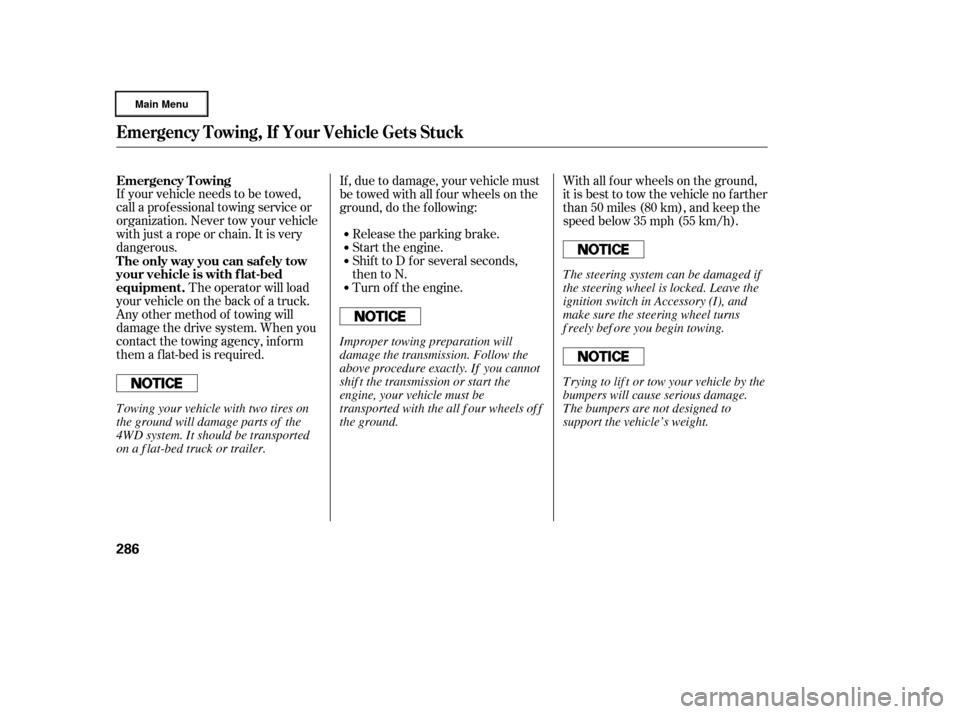Page 66 of 320

This indicator monitors the
temperature of the automatic
transmission f luid. It should come on
f or a f ew seconds when you turn the
ignition switch to ON (II). If it comes
on while driving, it means the
transmission fluid temperature is too
high. Pull to the side of the road
when it is saf e, shif t to Park, and let
the engine idle until the indicator
goes out.This indicator normally comes on f or
a f ew seconds when you turn the
ignition switch to ON (II). If it comes
on at any other time, there is a
problem in the 4WD system. Take
the vehicle to your dealer to have it
checked.
If the indicator blinks while driving,
the VTM-4 fluid temperature is too
high. Pull to the side of the road
when it is saf e, shif t to Park, and let
the engine idle until the indicator
goes out.
This indicator reminds you that the
exterior lights are on. It comes on
when you turn the headlight control
dial to either the or
position.
If you turn the ignition switch to
ACCESSORY (I) or LOCK (0)
without turning of f the headlight
control dial, this indicator remains on.
A reminder chime will also sound
when you open the driver’s door. Lights On Indicator A/T Temperature
IndicatorVTM-4 Indicator
Instrument Panel Indicators
Inst rument s and Cont rols
63
Continuing to drive with the A/T
temperature indicator on may cause
serious damage to the transmission.
Continuing to drive with the VTM-4
indicator blinking may cause serious
damage to the system.
�����—�
���—�����y�
�������������y���
�(�����������y���������y
Page 192 of 320

This section gives you tips on
starting the engine under various
conditions, and how to operate the
automatic transmission. It also
includes important inf ormation on
parking your vehicle, the braking
system, the VTM-4system, the VSA
system, the tire pressure monitoring
system, and f acts you need if you are
planning to tow a trailer.........................
Driving Guidelines .190
........................
Preparing to Drive .191
.......................
Starting the Engine .192
..............
Automatic Transmission .193
Variable Torque Management
.........
4WD (VTM-4) System .198
..............................
VTM-4Lock .198
Tire Pressure Monitoring System ......................................
(TPMS) .199
...........................................
Parking .201
.............................
Braking System .202
...............
Anti-lock Brakes (ABS) .203
Vehicle Stability Assist (VSA)
........................................
System .205
.................
Towing Weight Limits .207
..........
Towing Weight Guidelines .209
...........................
Towing a Trailer .210
Of f -Highway Driving
..................................
Guidelines .219
Driving
Driving
189
�����—���
�—�����y�
�������������y���
�(�����������y���
�����y
Page 289 of 320

If your vehicle needs to be towed,
call a prof essional towing service or
organization. Never tow your vehicle
with just a rope or chain. It is very
dangerous.The operator will load
your vehicle on the back of a truck.
Any other method of towing will
damage the drive system. When you
contact the towing agency, inf orm
them a f lat-bed is required. If , due to damage, your vehicle must
be towed with all f our wheels on the
ground, do the f ollowing:
Release the parking brake.
Start the engine.
Shif t to D f or several seconds,
then to N.
Turn of f the engine. With all f our wheels on the ground,
it is best to tow the vehicle no farther
than 50 miles (80 km), and keep the
speedbelow35mph(55km/h).
Emergency T owing
The only way you can saf ely tow
your vehicle is with f lat-bed
equipment.
Emergency Towing, If Your Vehicle Gets Stuck
286
Towing your vehicle with two tires on
the ground will damage parts of the
4WD system. It should be transported
on a f lat-bed truck or trailer. Improper towing preparation will
damage the transmission. Follow the
above procedure exactly. If you cannot
shif t the transmission or start the
engine, your vehicle must be
transported with the all f our wheels of f
the ground.The steering system can be damaged if
the steering wheel is locked. Leave the
ignition switch in Accessory (I), and
make sure the steering wheel turns
f reely bef ore you begin towing.
Trying to lif t or tow your vehicle by the
bumpers will cause serious damage.
The bumpers are not designed to
support the vehicle’s weight.
�����—���
�—�����y�
�������������y���
�(�����������y�������
�y